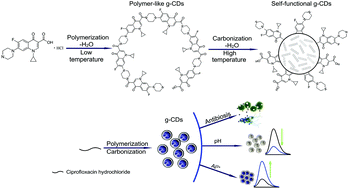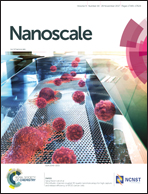An active structure preservation method for developing functional graphitic carbon dots as an effective antibacterial agent and a sensitive pH and Al(iii) nanosensor†
Abstract
Functional engineering is a crucial prerequisite for specific and wide applications of optical probes. In this study, we proposed a facile active structure preservation (ASP) method to directly develop new self-functional graphitic carbon dots (g-CDs) through a hydrothermal synthesis route by taking ciprofloxacin hydrochloride, an antibiotic belonging to a group of fluoroquinolone drugs, as an example. To retain the functional structures of the starting materials, the reaction temperature is intentionally controlled below the decomposition temperature of the reactants that hold the functional groups. As a proof of concept, we successfully prepared g-CDs with ciprofloxacin-like structures on its surface, as identified by mass spectrometric (MS) analysis. The as-prepared g-CDs not only exhibit effective antibacterial activity towards the bacteria Staphylococcus aureus (Gram-positive) and Escherichia coli (Gram-negative), but can also optically sense pH in the range from 5.02 to 9.91. Furthermore, the g-CDs can coordinate with aluminum ions to show a chelation-enhanced photoluminescence (CHEP) effect. These results indicate that the ASP method can be promising for engineering CDs with various properties.

- This article is part of the themed collection: Nanoscale 10th Anniversary: Top Authors


 Please wait while we load your content...
Please wait while we load your content...